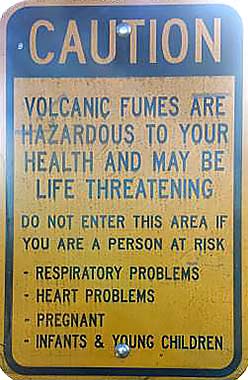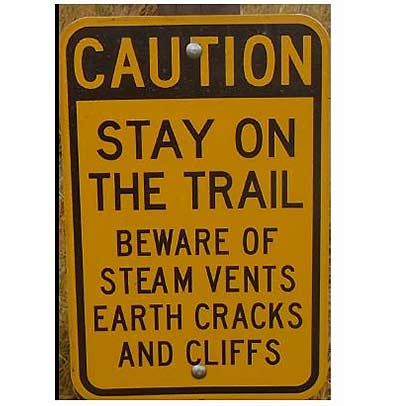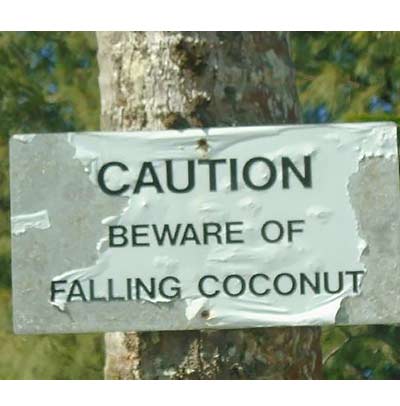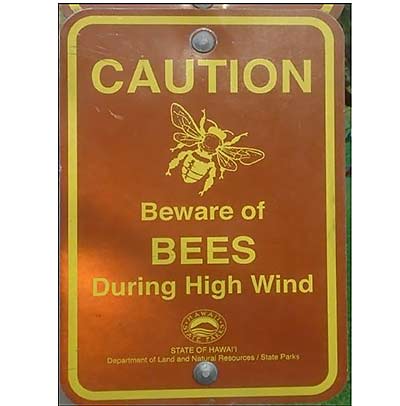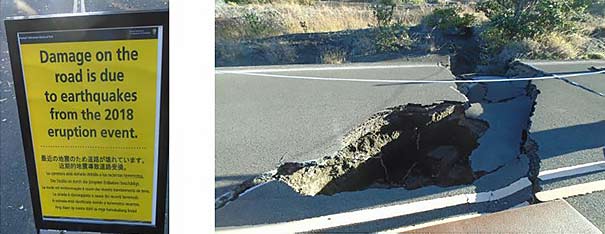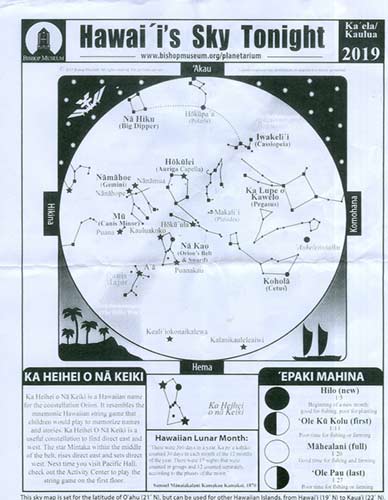Page 7

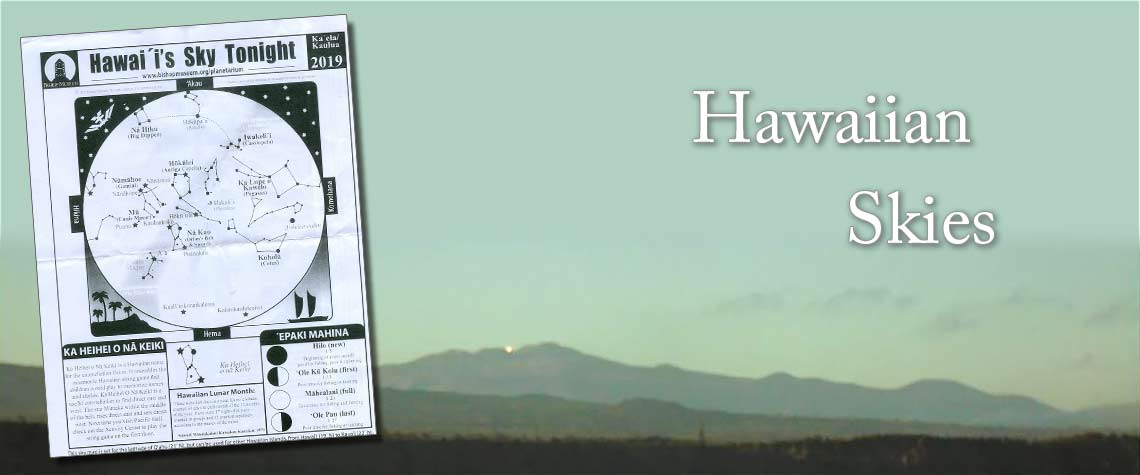
Hawaiian Skies
By Tim Cowden
When my wife announced that she and her sister were going to Hawaii for Christmas and that I could come along, my first thought was that I could see my old high school. When she mentioned the Big Island, (Hawaii, the one with the active volcanoes.) I started thinking of Mauna Kea and the telescopes. I looked up on line for star parties and found that the Visitors Center at Mauna Kea had them several nights a week, telescopes provided. I started to plan around the astronomy aspects of the trip.
I planned around taking the minimum amount of stuff. The Sky and Telescope Pocket Atlas was a must, as was a pair of 10x50 binoculars. The only other thing I took for star gazing was warm clothing. I didn't bring enough.
We got to Oahu before Christmas and saw the beaches and did touristy stuff before flying to the Big Island on Christmas Day. The moon was waning, but still dominated the late evening sky. Our first B&B on the Big Island was on the Kona coast, the west side of the island. It was cloudy with occasional clearing, and the night or two I spent star gazing with binoculars were pleasant but not unique. Days were spent snorkeling, sightseeing and shopping. I was waiting for the moon wane more before going up to Mauna Kea, a sixty mile drive. In looking at the travel guides, I started to see ominous sentences suggesting that driving up the highway that goes to the road up Mauna Kea could violate the terms of our rental car contract.
A check of the Mauna Kea website revealed worse news. As of late December, hours of the Mauna Kea Visitors Center were curtailed, star parties canceled for the next six months. The reason listed was the construction of new infrastructure for the safety and preservation of historical and cultural aspects of Mauna Kea and the observatory complex. This may have been part of an agreement for the construction of the new 30 meter telescope recently approved by the Hawaii Supreme Court.
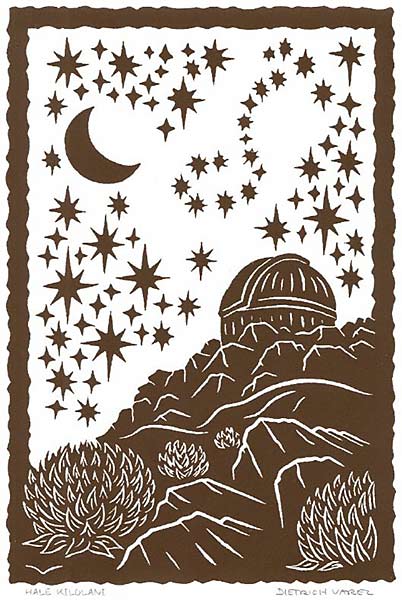
Block print by Dietreich Varez
I was crushed. Bad timing had killed one of the reasons for me to be there. Bad timing involving the government shutdown of national parks would disappoint my wife. But it is hard to be down for long in paradise. We moved to a B&B near the Kilauea Volcano and did more tourist stuff. The Volcano National Park was partially shut down with some volunteers helping to keep some of it open ( thanks, folks). Our B&B was in the rain forest, where we learned an important fact. It rains a lot. This produces riotous growth that inhibits stargazing.
I began to work on a backup plan. What I wanted to see was the southern stars I couldn't see from home. I was a just a few miles from the southernmost part of the United States, gaining over 11 degrees of southern latitude. A trip outside on a rare clear night in the rain forest revealed Omega Centauri higher in the sky than I'd ever seen it. Some bright stars below it, nestled amongst the tree ferns, proved to be the upper stars of the Southern Cross, according to the Pocket Atlas. I made plans to find a better observation site.
There is an old saying I just made up to the effect that if you don't like the weather in Hawaii, just drive a few miles. There is the wet windward side and the dryer leeward side. The rain is higher as you go up the slope and lower on the beach. A twelve mile drive to the dry side of the island would put me amongst the Mauna Loa lava flows at 3000 ft. This would give me a clear horizon to the south. I had seen Omega Centauri about 2:30 am. I set an alarm for midnight.
The circle of stars in the band at -60 degrees to -70 degrees declination is tight. Any given star will reach a maximum height above the horizon for about an hour or so. At midnight, it was too early for Centarus, but there was stuff that looked interesting. A check of the chart told me I was looking at the old constellation Argo, now broken into Carina and Vela, keel and sails. I started picking out the good stuff, the Carina Nebula and the Southern Pleiades. There were clusters everywhere in Vela. The Milky Way, even though this is the dimmer section away from the galactic center, stood out amazingly well. The air was very transparent, and the seeing was good. Even the old favorites like the Beehive Cluster were a joy look at in binoculars.
In spite of the tropical latitude, it was cold and windy at 3000 ft. Though I was wearing a coat over a thick shirt, and a woolly hat, I was cold. I packed it in before the Southern Cross was fully up. I planned to come back the next night at a later time.
The next night, I started at 2:30 am. The Southern Cross was up and most of Centaurus. My Pocket Atlas showed that the Coalsack dark nebula was next to the Cross, and it was readily visible in binoculars. Beta Centauri came up and it was a long wait for Alpha Centauri to rise above the horizon. I was happy with that and went back to the B&B. I would try the next night to find the top half of the Large Magellanic Cloud, but conditions weren't good and I had to be satisfied with what I had. The zodiacal light was incredibly bright.
The next day, we were walking the earthquake cracked road to the south rim of Kilauea at sunset when my wife asked me if those were the observatories. I said the volcano observatory was over on the far rim. “No, I mean the astronomy observatories.“ Sure enough, the top of Mauna Kea was visible with the domes shining gold from the setting sun. They were 35 miles away, as the crow flies. (See banner image at the top of the page.)
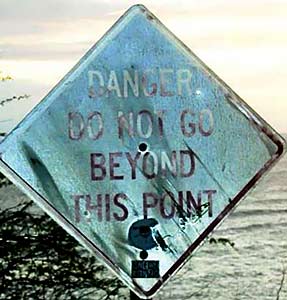
So that was it. I got to see constellations I hadn't seen for 50 years, hadn't even known to look for, back when I was getting my Astronomy merit badge. I wish I'd had even a small telescope, something that could travel as carry on luggage and hold a change of socks as well. Next project on the long list.
